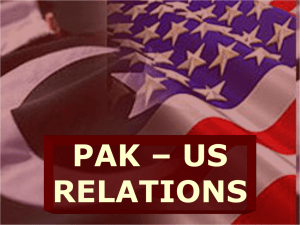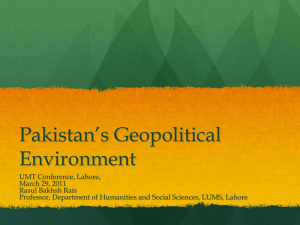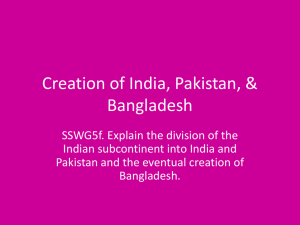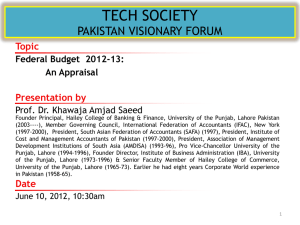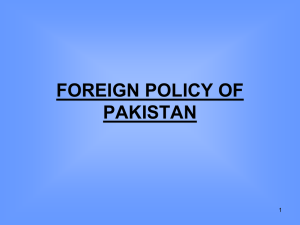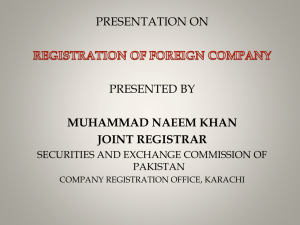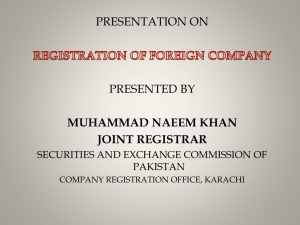West Pakistan
advertisement
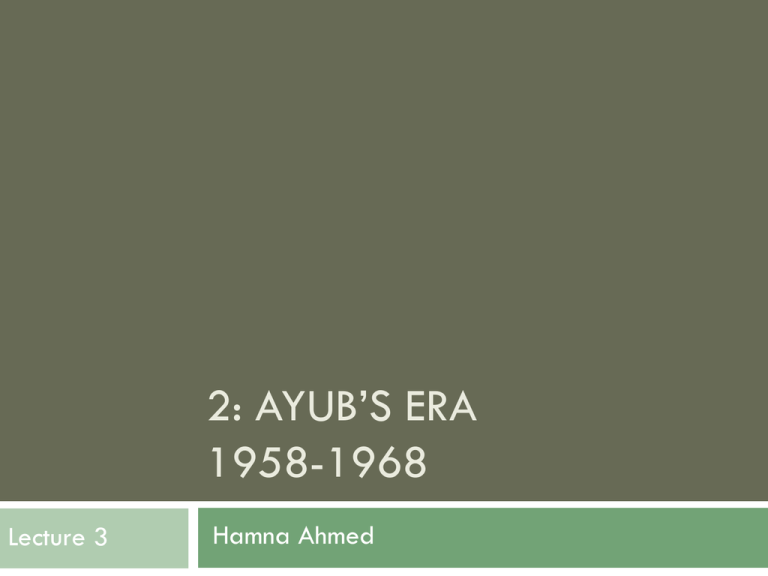
2: AYUB’S ERA 1958-1968 Lecture 3 Hamna Ahmed Introduction Military take over by General Ayub Khan in October 1958 It brought about a new era for development in Pakistan There had been considerable deterioration in the economic and political situation in the country Introduction Economic and social reforms were high on Ayub’s agenda These reforms included economic planning and providing basic needs such as food to the overall public of Pakistan. Introduction Large increase in flow of foreign assistance due to: Domestic political stability Strong political allignment with US through Pakistan’s membership in CENTO and SEATO CENTO: Central Treaty Organization Adopted in 1955 by Iraq, Turkey, Pakistan, Iran and Britain Introduction SEATO: South East Asian Treaty Formed in 1954, Comprised of Australia, Great Britain, France, New Zealand, Pakistan, the Philippines, Thailand, and the United States, Objective: Collective defense against aggression in south eastern Asia and the south western Pacific: Abolished in 1977. Growth Growth Targets First Five Year Plan: 3% Second Five Year Plan: 5% Third Five Year Plan: 6.5% GDP growth in Pakistan of nearly 7% per annum during the 1960s was exceeded among large countries only by Korea, Thailand and Mexico. Agricultural growth rate in Pakistan rose to a peak of 6.3% annual rate during 1965-1970 as record increases were registered in the production of wheat and rice. Growth Rates Measured by GDP growth, economic performance in Pakistan in the 1960s clearly exceeded initial expectations. 1950’s 1960’s Overall 1.9 4.0 Agriculture 1.9 2.7 Non-agriculture 2.9 5.0 Overall 3.1 6.7 Agriculture 1.4 5.0 Non-agriculture 5.0 7.9 East Pakistan West Pakistan Investment Table 3.2*: Fixed Investment (As percent of GDP) East Pakistan Private West Pakistan Public Total Private Public Total 1959-1960 2.0 4.0 6.0 4.3 7.2 11.5 1964-1965 4.5 8.1 12.6 11.6 9.2 20.8 1969-1970 4.0 8.4 12.4 7.0 7.3 14.3 Investment During 1960-1965 real investment grew very rapidly, reaching a peak of 21.5% of GDP in 1964-1965 before declining rather sharply to 14.6% in 1969-1970. Private investment growth in West Pakistan during 19601965 was explosive as it increased over three folds in short period of just five years. It declined by 20% in next five years but still during the 1960s, real private fixed investment more than doubled, grew faster than public investment, and accounted for nearly half of the total fixed investment by 1969-1970. Investment Reasons for increased investment: Political stability Liberalization of investment controls Availability of foreign exchange The increase in investment contributed to an increase in economic growth naturally. Defence vs Development The squeeze on West Pakistan’s investment came from two resources: Sharp increase in defence spending Conscious effort to increase development outlays Following the war with India in 1965, defence allocations were given high priority and phasing out of US military assistance after 1965 put additional burden on domestic resources. Defence vs Development Table 3.3: Defence vs. Development (Rs. Billion) Development Spending Defence Spending 19601965 Actual 13.95 1965-1970 1965-1970 Planned 30.00 Actual 21.75 (7.1) 5.50 (2.8) (9.8) 6.89 (2.2) (7.1) 12.38 (4.0) Inflation Inflation remained in check - the average annual rate of growth of prices was only 3.3% As a part of the package of measures to fight inflation, government borrowing from the banking system for financing fiscal deficits was reduced sharply. Tax mobilization The 1960s were the only period in Pakistan’s fiscal history when significant public savings i.e. the excess of government revenues receipt over revenue expenditures materialized. Efforts to broaden the direct taxation system kept the indirect taxation to minimum and hence prices of goods remained stable. Needs of additional defence spending were met by additional taxation. Substantial additional taxation, undertaken especially during the Third Plan, helped to increase the ratio of taxes from 6.1 % of GDP in 1959-60 to 7.6% in 1969-70. Problems and Failures Negligence of Social sector Pre occupation with increasing long term investment in water and power and raising food grain production after 1966 led to major neglect of Social sector investments. Ignored education and health. Problems and Failures Foreign Aid and Domestic Savings Too much concentration on foreign aid mobilization led to a relative neglect of domestic saving effort. Led to problems of debt – an issue which the economy faces even today. Problems and Failures Widening Regional Disparities: The sharp acceleration of growth in West Pakistan during the 60s meant that even though the growth rate in East Pakistan also increased significantly, the regional disparity in incomes widened. In 1970, West Pakistan’s per capita GDP was at least 60 % higher than that of East Pakistan The Planning Commission What sets the 1960’s apart from the other periods in Pakistan’s economic history is the central role given to the planning process as a tool of economic policy making and coordination The Planning Commission The Second and Third Five Year Plans: Quickly became out of date as the central assumptions underlying them changed significantly within months of their finalization. In case of second plan, much larger foreign aid availability made possible a more than 40% expansion in public sector development spending over original levels. In case of third plan, the opposite happened. The Second Five Year Plan (1960-1965) had originally set a target of GDP growth of 20% over five years compared with the modest goal of 15% in the First Five Year Plan. The Third Plan (1965-1970) formulation was undertaken in a mood of great optimism and the annual growth target was set at 6.5% per annum. Water and Power Investments Massive investments including the Indus Basin Replacement Works spending Total water and power investments in West Pakistan during the 1960s accounted for more than 50% of total public sector spending The most explosive of Indo-Pakistan disputes was the question of sharing the waters of the Indus basin. International Bank for Reconstruction and Development offered the offices of the Bank for the solution of the water problem Water and Power Investments A solution acceptable to both governments was agreed upon in 1960 at the Indus Basin Development Fund Agreement at Karachi. This treaty is commonly known as the "Indus Water Treaty” Tarbela Dam: Reluctant donors were persuaded to include Tarbela dam in Indus Works. Completed in 1971, just in time when there was oil price hike (1973-OPEC) which made thermal power extremely expensive Foreign Aid Political alignment with the US through Pakistan’s membership in: Central Treaty Organization (CENTO) -1954 South East Asian Treaty Organization (SEATO) - 1955 By the mid 60s net foreign aid flows were financing over one third of total investment spending, over 45% of imports and meeting much of the gap in food grain supply for Pakistan as a whole. Foreign Aid: The consequences of Growing Dependence Foreign aid -> domestic saving effort Excessive concentration on foreign aid mobilization led to relative neglect of the domestic saving effort Led to the problems of foreign debt which we are still facing today Trade policy Like many developing countries, Pakistan did not give importance to its exports during initial period. Performance > Expectations Between 1960 and 1970, West Pakistan exports increased by around 7 % annually, more or less in line with the growth of output Turnaround in 1960s: Due to expansion in the export of manufactured goods which registered real annual growth of over 20% in the 1960s. However, exports were narrowly focused on cotton textiles and required large export subsidies through Export Bonus Scheme There was no significant improvement in the structure of exports over the period. Export Bonus Scheme Introduced in January 1959 Provide incentives for exporters of manufactured goods financed from the excess profits which could be made on imports due to the overvaluation of exchange rate By 1966-7 the premium on the bonus voucher had increased to 160%. For importers using bonus vouchers for imports, it meant a cost of foreign exchange of Rs 12.35 per US dollar (against the official rate of Rs 4.76). The main purpose of the scheme was to increase non traditional exports but, at the margin transferred excess import profits to exporters of manufactured goods. Export Bonus Scheme was a system of multiple exchange rates which: 1. Sustained a high degree of overvaluation of the official exchange rate 2. Seriously distorted incentives between agriculture and industry and within industry 3. Led to a lack of transparency and stability in export incentives. Ayub Khan’s Policies – An Assessment Quickening the tempo for growth Dramatic turnaround in investment and growth in both East and West Pakistan. This development momentum was seriously disrupted by the 1965 war with India. Reduction in foreign aid availability and increased defence spending squeezed investment. Growth of GDP remained high both in East and West Pakistan in the second half of 1960s but this was concentrated mostly in agriculture in West Pakistan. In economic policy terms, major failures were the perpetuation of the industrial and trade policies of 1950s and an excessive reliance on external assistance. Comment on the performance of the industrial and the agricultural sector during the formative years i.e. 1947-58. What policies were responsible for this performance?

